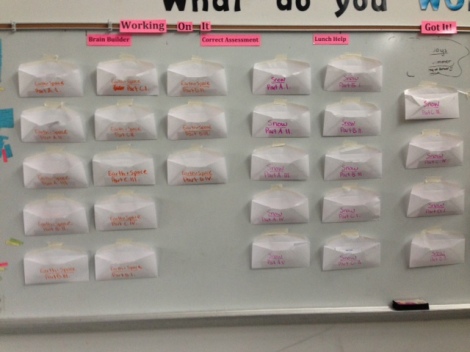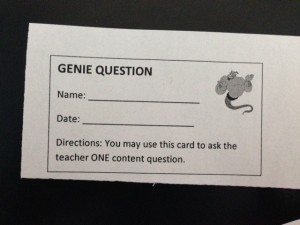Interdisciplinary Assessment: Combining Literacy, Science, and Mathematics
by
Michaela Duggan
Every class at BCCS ends the year with a final. This year, I decided to try something different—instead of a paper and pencil test, students would complete tasks modeled off the Next Generation Science Standards sample tasks. The goal was for the final to reflect students’ ability to do science rather than their ability to memorize facts and by using their science knowledge in various ways improve their understanding and retention of the facts.
The NGSS tasks combine science, math and literacy standards. By switching to a task final, the assessment in and of itself reflects the interdisciplinary nature of science and gives students a chance to review math skills for their math final. In designing the tasks I collaborated with Ms. Adam, the 6th Grade math teacher, who helped revise the tasks to ensure that the math was an appropriate level of rigor and that scaffolding was in place for all students to be successful.
Designing Complex, Relevant Tasks
Only one of the existing sample tasks aligned to the science content covered—the antibiotic resistance task. The task covers the science topics of natural selection, traits and adaptations as well as science skills of graphing and interpreting data. The math skills included percents and linear equations. Linear equations are not covered in 6th grade so we adapted the task to identifying patterns in graphs instead of determining the equation.
The Antibiotic Resistance task is complex and challenging—exactly what I wanted students to be doing—however, I wanted students to have a choice for their final. To make this possible I created 4 other tasks that included topics from the different units throughout the year. In designing the tasks, the driving factor in selecting topics was relevance. I wanted students to see that science is used every day and that to do science well, you need to use math.
The four additional tasks focused on photosynthesis and carbon in the environment, designing and finding a location for roller coasters, snow and snow removal, and identifying locations on Earth using solar and lunar phenomena. Each piece includes science topics from multiple content units, graphing, and one or more math skills.
Strategies to Promote Perseverance
To help students succeed with the tasks we used three systems in class. First, students had access to their folders. For each unit throughout the year, students create a folder that we call their “mini-textbook.” During the unit, students add notes pages in order and create a Table of Contents to organize and locate information.
At the end of each unit I collected the folders—one, so students would not get confused and bring the wrong one to class and two so that students would have resources from each unit for finals. The folders are organized in the back of the room and students can get up and use them during class as a resource.
The other two strategies—hint cards and genie questions—come from routines used by our Math 2 Teacher, Ms. Garcia. Each class, students receive two hint cards at the beginning of class.
When they need a hint, students can trade their hint card for an actual hint. There is a hint for each section of each task organized in envelopes around the room. The hints could be prompting questions I would ask students, formulas and/or facts.
The genie question is a free question pass. Each student gets one genie card at the beginning of each class and can use it to ask one content question. The genie question is particularly helpful for promoting perseverance because students only want to use it when they truly can’t figure it out on their own.
Each class starts with 10 minutes of silent, independent work where students can use their hint cards, genie cards and folders. If students are professional for the entire 10 minutes they earn partner privileges and can work with classmates. This partner time helps with perseverance as well as students truly lean on each other to find the answers.
Grading
To grade the tasks, I created a grading sheet for each one. The grading sheet matches the questions of each task. If it is a numeric answer, it is marked as correct or incorrect. Graphs, diagrams and content questions are each scored out of 4 points based on the rubrics below.
| 4 | 3 | 2 | 1 | 0 | |
| Graph | Graph is correct type, includes all data, a title, appropriate scale, y axis label, X axis label and a key. | Graph is missing one component. | Graph is missing 2 components. | Graph is missing 3 or more components. | There is no graph. |
| 4 | 3 | 2 | 1 | 0 | |
| Diagram | Diagram is accurately drawn and labeled. All necessary components are included.Diagram is neat and easy to interpret. | Diagram is accurately drawn and labeled. All necessary components are included. | Diagram is accurately drawn and labeled. Some components are missing. | Diagram is accurately drawn but missing labels and components. | There is no diagram or the diagram is wrong. |
| 4 | 3 | 2 | 1 | 0 | |
| Content | Answer is correct and includes all necessary components. Each component is explained in detail showing a deep understanding. | Answer is correct and includes all necessary components. | Answer is correct and includes most components. | Answer is correct but is missing pieces. | There answer is incorrect. |
Reflections
Being two days away from finishing this project, I would consider it a success. Students worked hard throughout the process, used their resources and grappled with the ideas. My favorite part was seeing students who struggled through a task for days then explain it to a peer—the immediate progress was impressive. That being said there are several things I would change for next year.
For the tasks themselves, the one piece of the year long course that was not emphasized within the texts was literacy. Throughout the year we do a lot with text and particularly research. Moving forward, I want to revise each task to include a small non-fiction text research component. For example, for the snow task, students could research various methods of snow removal throughout history and evaluate each.
When grading, the quality of answers was not to the level I hoped for—particularly for content explanations. To improve this aspect for next year, I want to provide students with sample answers, graphs and diagrams when I first introduce them to the project and have them score each using the rubrics. By norming on what is expected from the first day, rather than almost at the end, hopefully the products will be a higher level of quality.
Student Work
Here are the versions of the NGSS tasks the students could choose from:
Please find below some student work grouped by task. Enjoy!
Antiobiotic Resistance:
Earth and Space:
Photosynthesis:







Pingback: Interdisciplinary Assessment: Combining Literac...·
Pingback: #teachervoice on #NGSS Assessment: Combining Li...·
Pingback: Interdisciplinary Assessment: Combining Literacy, Science, and Mathematics | Transitioning to the Common Core | Learning Curve·
Pingback: #teachervoice on #NGSS Assessment: Combining Li...·